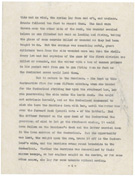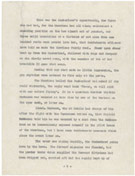War at Sea
Lt. Thomas O. Selfridge, Jr. - Sinking of the USS Cumberland, 1862
On Saturday, March 8, 1862, one year after the onset of the Civil War, the crewmen of the Union blockade squadron standing off at Hampton Roads, Virginia, had grown bored waiting for the enemy’s arrival. While the laundry hung on the Union ships’ rigging drying in the midday sun, the Confederate ironclad CSS Virginia steamed slowly from Norfolk toward the Union fleet. Until that day, no one knew how an ironclad would perform in battle against a fleet of wooden ships. The engagement began close to 3 p.m. When it was over, before dark, the USS Cumberland was sunk, the USS Minnesota had been forced aground, and the USS Congress surrendered and then was burned. With the support of the Confederate gunships CSS Beaufort and CSS Raleigh, the Virginia had devastated the Union fleet, signaling that the era of wooden battleships would soon come to an end. The USS Cumberland was fired upon, rammed, and sunk, in a dramatic demonstration of the ironclad’s superiority in battle. The gallantry of the Cumberland’s crew—who fought beyond all hope, refusing to surrender even as their ship went down—was immortalized in poems by Herman Melville, Henry Wadsworth Longfellow, and others. Lt. Thomas O. Selfridge, Jr., who commanded one of the ship’s gun divisions, survived the battle, and wrote this vivid and graphic account of it twenty-three years later.
“From an Address on the ‘Cumberland’ prepared by Admiral Selfridge,” 1885, page 3
Selfridge pays tribute to the seamen on board the Cumberland who continued to work their guns even as their comrades fell and their ship began to sink. He conveys the grisly chaos of nineteenth-century naval warfare: the noise of the guns, the smoke of the gunfire, the decks awash with blood and littered with the body parts of the fallen.
Of the 376 men known to be aboard the Cumberland on March 8, 121 were killed.
National Archives, Naval Records Collection of the Office of Naval Records and Library
Excerpt:
“Her first shot passed through the starboard hammock netting, killing and wounding nine Marines and their Commander. . . The groans of these men the first to fall as they were carried below was something new to those crews as they stood at their guns, and an introduction to a scene of carnage unparallelled in the war . . .
The Captain of [the No. 1 gun], a splendid seaman named Kirker rated Commodore’s coxswain, had both arms taken off at the shoulder as he was holding his handspike and guiding the gun. He passed me as he was carried below but not a grown escaped from him. . . .”
—From Admiral Selfridge’s account
.
“From an Address on the ‘Cumberland’ prepared by Admiral Selfridge,” 1885, page 4
Selfridge pays tribute to the seamen on board the Cumberland who continued to work their guns even as their comrades fell and their ship began to sink. He conveys the grisly chaos of nineteenth-century naval warfare: the noise of the guns, the smoke of the gunfire, the decks awash with blood and littered with the body parts of the fallen.
Of the 376 men known to be aboard the Cumberland on March 8, 121 were killed.
National Archives, Naval Records Collection of the Office of Naval Records and Library
Excerpt:
“The dead were thrown over the other side of the deck, the wounded carried below: no one flinched but went on loading and firing, taking the place of some comrade killed or wounded as they had been taught to do. But the carnage was something awful . . .
. . . Every 1st and 2nd captains of the guns of the first division was killed or wounded, and the writer with a box of cannon primers in his pocket went from gun to gun firing them as fast as the decimated crews could load them. . . .”
—From Admiral Selfridge’s account
.
“From an Address on the ‘Cumberland’ prepared by Admiral Selfridge,” 1885, page 5
Selfridge pays tribute to the seamen on board the Cumberland who continued to work their guns even as their comrades fell and their ship began to sink. He conveys the grisly chaos of nineteenth-century naval warfare: the noise of the guns, the smoke of the gunfire, the decks awash with blood and littered with the body parts of the fallen.
Of the 376 men known to be aboard the Cumberland on March 8, 121 were killed.
National Archives, Naval Records Collection of the Office of Naval Records and Library
Excerpt:
“Seeing that our shot made so little impression, the gun captains were ordered to fire only at the ports.
The Merrimac hailed the Cumberland and asked if she would surrender, the reply went back ‘Never, we will sink with our colors flying . . .’ ”
—From Admiral Selfridge’s account
.
The Sinking of the Cumberland, hand-colored lithograph by F. Newman, published by Currier & Ives, ca. 1862
Courtesy of the Library of Congress, Prints and Photographs Division, Washington, DC
.
U.S. Frigate Cumberland, 54 Guns. The flag ship of the Gulf Squadron, Com. Perry, lithograph by N. Currier, 1843
Selfridge described the Cumberland as “a splendid type of the frigate of the old times, with her towering masts, long yards, and neat man-of-war like appearance.”
Courtesy of the U.S. Navy Art Collection, Washington, DC
.
CSS Virginia, wash drawing by Clary Ray, 1898
In 1861, the Confederates salvaged the USS Merrimack, which Federal forces had scuttled and burned when forced to abandon the Navy Yard in Norfolk, and converted her into an ironclad that they christened the CSS Virginia.
Many people, including Selfridge, continued to refer to the ironclad as the Merrimack.
Although the CSS Virginia prevailed on March 8, 1862, she did not escape unscathed: her iron ram was lost, her stack riddled, and two large guns were put out of order.
Courtesy of the U.S. Navy Art Collection, Washington, DC
.
Rear Adm. Thomas O. Selfridge, Jr., not dated
National Archives, Records of the Bureau of Ships [19-N-13128]
.






